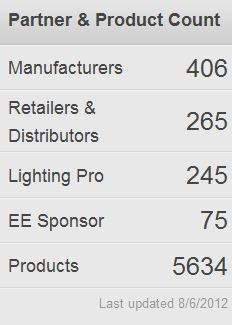Lighting Facts institutes QA testing, requires annual product updates 06 Aug 2012 Beginning October 1, the LED Lighting Facts program will begin charging a fee for annual product listings. It has already begun quality assurance testing, which results in a green double-check mark on the label upon verification. At the LED Show last week, Marci Sanders of D&R International, an environmental and energy efficiency consulting firm, presented an update of recent revisions to the Lighting Facts program aimed at further improving the integrity of products that carry the Lighting Facts label. The biggest change is that Lighting Facts will now require that manufacturers update the status of their listed products annually. Sanders explained, "As of October 1, 2012, any product that has been on the list for more than one year will have to be updated to assure whether it is available on the market and to give the opportunity to update performance changes that have taken place since the listing."
This change is designed to provide users better visibility into whether products containing the Lighting Facts label are commercially available, available through special order, or not available on the market.
Manufacturers will also need to pay an annual fee for its Lighting Facts listed products -- $100 for existing products or $150 for new products. This fee will be waived in the case of Energy Star qualified or products on the qualified product list of the DesignLights Consortium (DLC). The fee will also be waived for the first year if manufacturers volunteer to have their products quality assurance (QA) tested by Lighting Facts. Initially, only those products volunteered for testing by the manufacturers will be QA tested.
The new QA program involves testing of the product (LED lamp or luminaire) for the mandatory metrics listed on the Lighting Facts label as well as a variety of optional metrics. Lighting Facts will recommend a number of labs from which manufacturers can choose to have the testing done. Testing cost will be paid by the manufacturer. QA testing will be performed only by independent labs that are physically located in the US and are LED Lighting Facts Approved Lab Partners for IES LM-79 total flux and color testing as well as intensity distribution test procedures.
If a product tests within the tolerances of the metrics listed by the manufacturer on the label, the label will get a green double-check mark. "The green double-check designation is the first real way for manufacturers to differentiate products on the product list for Lighting Facts," said Sanders. She added that if testing results in values different from those indicated by the manufacturer, the manufacturer will be given the opportunity to revise the values and still get the green double-check mark. Once the double-check mark is assigned, it will appear on that product for two years. A list of frequently asked questions and answers is available here.

Running tally of LED Lighting Facts partners.
Aside from providing fee waivers for Energy-Star and DLC qualified products, Lighting Facts is providing volume discounts to manufacturers who choose to list multiple products or to manufacturers that can provide full LM-79 data upon submission. In addition, QA tested products will also become part of the DOE's Caliper database of benchmark tested products.
Sanders noted that 60 utilities in the US are Lighting Facts partners and provide information regarding product rebates on the Lighting Facts website. To date, over 5600 products from 406 manufacturers carry the Lighting Facts label, and partners include 75 energy efficiency program sponsors (EE sponsors), 265 retailers and distributors and 245 lighting professionals. Retailers, distributors, lighting professionals and EE sponsors do not need to pay any fees to participate in the Lighting Facts program.
In the coming weeks, Lighting Facts will hold a number of webinars to educate LED lighting manufacturers and users regarding the changes.





